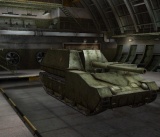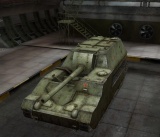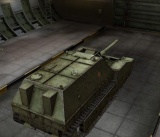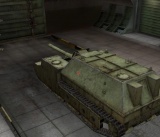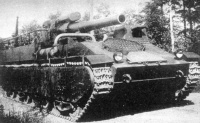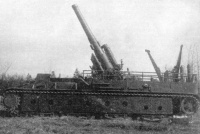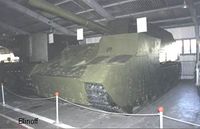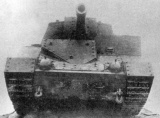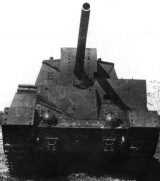SU-14-2
| Revision as of 01:52, 2 May 2012 links and wording | Revision as of 05:54, 2 May 2012 | |||
| Line 2: | Line 2: | |||
| {{panel title|icon=[[image:USSR-SU-14.png|link=|left]]|rMargin=248px|content= | {{panel title|icon=[[image:USSR-SU-14.png|link=|left]]|rMargin=248px|content= | |||
| ? | The '''SU-14''' is a [[USSR|Soviet]] tier 6 [[Self Propelled Guns|self-propelled gun]]. Out of the box, it's armed with the 152mm BR-2; which is not that powerful compared to the 152mm howitzer on the [[SU-8]], other than a small increase in range. Its hull is armored enough to withstand attacks from scout tanks, but at the expense of mobility, even slower than the [[Maus]]. After a few dozen matches, you will get the 203mm B-4 that packs a punch that can destroy most tanks with a few rounds. But, the 203mm B-4 has a very slow rate of fire, so make every effort to ensure that each shell hits its target. The only advantages its counterpart, the [[S-51]], has is more hit-points, a slightly increased rate of fire, and more ammunition storage. The SU-14 is considered more dangerous than the S-51 because some players in the S-51 (which unlocks from the [[KV]]) may not have played any of the earlier artillery, and thus | + | The '''SU-14''' is a [[USSR|Soviet]] tier 6 [[Self Propelled Guns|self-propelled gun]]. Out of the box, it's armed with the 152mm BR-2; which is not that powerful compared to the 152mm howitzer on the [[SU-8]], other than a small increase in range. Its hull is armored enough to withstand attacks from scout tanks, but at the expense of mobility, even slower than the [[Maus]]. After a few dozen matches, you will get the 203mm B-4 that packs a punch that can destroy most tanks with a few rounds. But, the 203mm B-4 has a very slow rate of fire, so make every effort to ensure that each shell hits its target. The only advantages its counterpart, the [[S-51]], has is more hit-points, a slightly increased rate of fire, and more ammunition storage. The SU-14 is considered more dangerous than the S-51 because some players in the S-51 (which unlocks from the [[KV]]) may not have played any of the earlier artillery, and thus are inexperienced. In the game, it is widely known as a "School Bus" due to its shape. | |
| :The SU-14 leads to the [[Object 212]]. | :The SU-14 leads to the [[Object 212]]. | |||
| }}{{:{{PAGENAME}}/Modules}}{{:{{PAGENAME}}/Equipment}}{{:{{PAGENAME}}/Consumables}} | }}{{:{{PAGENAME}}/Modules}}{{:{{PAGENAME}}/Equipment}}{{:{{PAGENAME}}/Consumables}} | |||
Revision as of 05:54, 2 May 2012
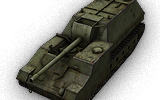
The SU-14 is a Soviet tier 6 self-propelled gun. Out of the box, it's armed with the 152mm BR-2; which is not that powerful compared to the 152mm howitzer on the SU-8, other than a small increase in range. Its hull is armored enough to withstand attacks from scout tanks, but at the expense of mobility, even slower than the Maus. After a few dozen matches, you will get the 203mm B-4 that packs a punch that can destroy most tanks with a few rounds. But, the 203mm B-4 has a very slow rate of fire, so make every effort to ensure that each shell hits its target. The only advantages its counterpart, the S-51, has is more hit-points, a slightly increased rate of fire, and more ammunition storage. The SU-14 is considered more dangerous than the S-51 because some players in the S-51 (which unlocks from the KV) may not have played any of the earlier artillery, and thus are inexperienced. In the game, it is widely known as a "School Bus" due to its shape.
- The SU-14 leads to the Object 212.
R27 SU-14/ModulesR27 SU-14/EquipmentR27 SU-14/Consumables
Historical Info
The experimental SU-14 was built in 1934 (possibly 2 were built) as heavy self-propelled guns for mechanized units for the destruction of strengthened fortifications.
Specifications: weight- 48,5 t; crew- 7 men; armament- 203mm howitzer B-4 mod. 1931 (range of fire 18 km with 100 kg shell, rate of fire 1 shot/5.7 min) + 3 x 7,62mm MG;- ammunition 8 shells + 2268 MG shells; armor 10-20 mm; engine M-17 500 hp; speed- 27.3 km/h; range 100-120 km.
The SU-14 was based on the T-35 chassis with other elements from both the T-28 and T-35. The engine was located in the front and the howitzer was openly-mounted. The original SU-14 had the 203mm B-4. The SU-14 was equipped with two 200 kg cranes for use with the ammunition, two spades, and had to have its suspension disconnected during firing; it could fire only from the stationary position. Its maneuverability and speed were satisfactory. Also, operation of the howitzer was convenient. But, its size was large, armor was insufficient, and it had problems with over-driven transmissions.
The SU-14 was tested in 1935 and its engine and transmission were modified (improved SU-14-1 was built in 1936 - it had better and more reliable transmission, improved spades, more powerful engine M-17F 680 hp.). On both SPGs, the 203mm howitzer was replaced by the 152.4mm naval gun B-30 and Br-2 (which had better range and rate of fire) in 1936. It was planned to produce 5 copies with the 152.4mm gun Br-2 (SU-14-2), but that plan was rejected due to the arrest of the chief engineers of the project.
See left most (or top most) blueprint below.
In 1936, the new experimental self propelled gun SU-14-1 was built and tested. It was the improved version of the SU-14 with the transmission from a T-35 heavy tank (not from T-28 medium tank as in the case of SU-14), more powerful engine, modernized spades, and without the ineffective suspension needing to be disconnected during firing. An additional artillery tractor, “Comintern”, was used as ammunition carrier (50-60 shells) for the SU-14-1. See right most (or bottom most) blueprint above.
In 1936, the 203mm howitzer was also replaced by the 152.4mm gun Br-2 mod.1935 with better range and rate of fire. The SU-14-1 was equipped with a radio station and additional armor in 1940 for use during the Winter War against Finnish fortifications (Mannerheim line) from a short distance. That SP gun was renamed the SU-14-Br2 and was the predecessor of heavy SP guns of the WWII period. Now, the SU-14-2 is preserved at the Russian tank museum (Kubinka).
Combat Usage
The Winter War
The SU-14 was used quite successful in the destruction of Finnish fortifications during the Winter War.
World War II
In April 1940, the SU-14 and SU-14-1 were going through tests in NIAP, and in July, were in P.F. Lebedev's tank group in the Keiv Region. In September 1940, both units were given to NIBT for storage. In the fall of 1941, when defending Moscow, both SU-14s and an experienced SU T-100-U in a unit called "Separate Heavy Division for Special Purposes" were used in the Kubinka Region to fire from protected positions at advancing German forces (likely, they were using any working weapon available).
Variants
- SU-14 -- Armed with 203mm howitzer B-4 mod. 1931 + 3 x 7,62mm MG; ammunition 8 shells + 2268 MG shells; armor 10-20 mm; engine M-17 500 hp; speed 27,3 km/h; range 100-120 km
- SU-14-1 -- Armed with 203mm howitzer B-4 mod. 1931 + 4 x 7,62mm MGs; ammunition 8 shells + 2196 MG shells; armor 6-20 mm; engine M-17F 700 (850?) hp; speed 30-35 km/h; range 120-150 km.
- SU-14-Br2 -- Armed with 152.4mm gun + 4 x 7,62mm MG; ammunition 16 shells + 2655 MG shells; armor 20-50 mm; speed 15 km/h; range 100 km.
- SU-14-2 -- SU-14-1 with the radio station.
AUTHOR'S NOTE
The variant descriptions and the pictures don't exactly match (they came from 2 different sources). It is relatively clear that only 3 vehicles were produced. 2 were likely the SU-14 with the 203mm and 1 was the SU-14-1 with the 203mm. Later, the 203mm gun was replaced with the 152.4mm gun. However, from the 3 pictures directly above, we get some discrepancies. One picture (1st in the row of 3 above) shows the front view of an SU-14 with both armor AND the short 203mm gun. This does not have a variant name. Likewise, the 3rd picture in the group of 3 shows the original plating between the tracks (you can see where it extends to cover the drive wheels and has rectangular holes instead of circular ones). From the the blueprints, this is an SU-14 and not the SU-14-1 modified to an SU-14-Br2. I'm assuming that the armor was tacked on to one (or more likely both) of the original SU-14 prototypes, but they left the 203mm howitzer in. Possibly, this was done so they could participate in the Winter War.
- [Source of most of the pictures]
- [More History in Russian]
- Russian Tanks and Armored Vehicles 1917-1945
| Light Tanks | MS-1 • BT-2 • Tetrarch • T-26 • T-60 • BT-7 • BT-SV • LTP • M3 Light • T-127 • T-46 • T-70 • A-20 • T-50 • T-80 • Valentine II • T-50-2 • MT-25 |
| Medium Tanks | A-32 • T-28 • Matilda IV • T-34 • T-34-85 • A-43 • KV-13 • T-43 • A-44 • T-44 • Object 416 • T-54 • Object 430 II • Object 283 • T-62A • Object 140 • Object 430 |
| Heavy Tanks | Churchill III • KV • KV-1 • KV-220 • KV-220 Beta-Test • KV-1S • KV-2 • T-150 • IS • KV-3 • IS-3 • IS-6 • KV-4 • KV-5 • IS-8 • ST-I • IS-4 • IS-7 |
| Tank Destroyers | AT-1 • SU-76 • SU-85B • SU-85 • SU-85I • SU-100 • SU-100Y • SU-100M1 • SU-122-44 • SU-152 • ISU-152 • SU-101 • Object 704 • SU-122-54 • Object 263 • Object 268 |
| Self-Propelled Guns | SU-18 • SU-26 • SU-5 • SU-122A • SU-8 • S-51 • SU-14-1 • SU-14-2 • 212A • Object 261
|
| USA | II T1 HMC • III T18 HMC • III M7 Priest • IV T82 HMC • IV M37 • V M41 HMC • VI M44 • VII M12 • VIII M40/M43 • IX M53/M55 • X T92 HMC |
| UK | II Loyd Gun Carriage • III Sexton II • III Sexton I |
| Germany | II G.Pz. Mk. VI (e) • III Sturmpanzer I Bison • III Wespe • IV Pz.Sfl. IVb • IV Sturmpanzer II • V Grille • VI Hummel • VII G.W. Panther • VIII G.W. Tiger (P) • IX G.W. Tiger • X G.W. E 100 |
| France | II Renault FT 75 BS • III Lorraine 39L AM • IV AMX 105 AM mle. 47 • V AMX 13 105 AM mle. 50 • V 105 leFH18B2 |
| USSR | II SU-18 • III SU-26 • IV SU-5 • V SU-122A • VI SU-8 • VII S-51 • VII SU-14-1 • VIII SU-14-2 • IX 212A • X Object 261 |
| China | |
| Japan | |
| Czechoslovakia | |
| Sweden |
